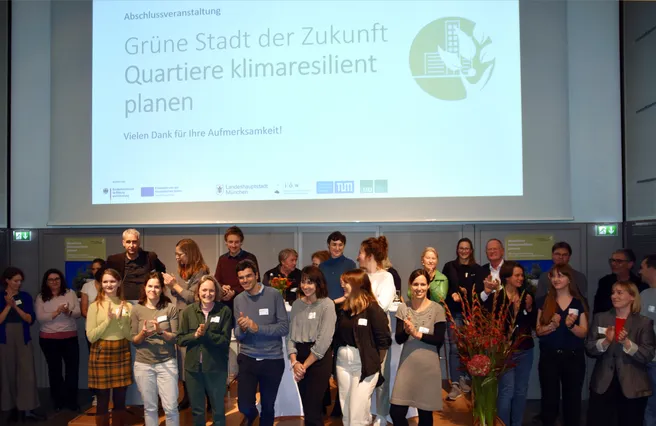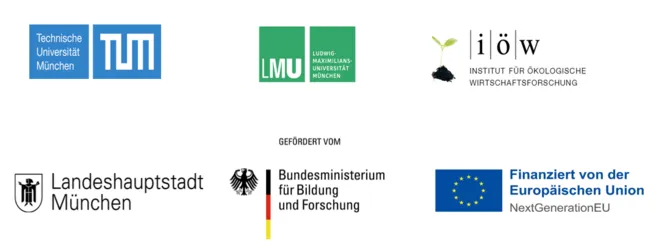Cities are increasingly suffering from heat and heavy rainfall. Sufficient urban greenery is crucial for climate adaptation - but tree felling and sealing are particularly prevalent in growing cities. How can green spaces be integrated into urban planning and conflicts of use minimized?
On November 6, 2023, the "Green City of the Future" project came together for a final conference to present the results of five years of research and development as well as implementation and continuation. The event was followed by 130 participants on site and 240 people via livestream. The interdisciplinary project team from the City of Munich, the Technical University of Munich, the Ludwig Maximilian University of Munich and the Institute for Ecological Economy Research (IÖW) compiled best practices and recommendations. The project is funded by the Federal Ministry of Education and Research (BMBF).
"The project has succeeded in testing theoretical research approaches in practice using real-world laboratories and integrating them perfectly into local planning processes. The results have great added value due to their high relevance for implementation and motivate us to continue integrating climate resilience more strongly into urban development planning. In addition, not only were important insights gained for the implementation of climate resilience in new-build districts, but numerous practical options for action were also identified for existing districts, which will be incorporated into our work."
City Planning Councilor Professor Dr. (University of Florence) Elisabeth Merk
"The effects of climate change, scarce land resources and the simultaneous provision of housing pose major challenges for growing cities like Munich. This is why such interdisciplinary research projects are so important in order to jointly design a climate-resilient and livable city for Munich's residents. The results of the research project will be incorporated into the development of urban standards and processes."
Christine Kugler, Officer for Climate and Environmental Protection
More green through urban planning, neighbourhood work and activating urban society
In order to bring more greenery into the city, the researchers investigated different planning processes and neighborhood types as well as the effectiveness of various climate resilience measures. On the other hand, they analyzed key stakeholders, their expectations and conflicts of use, for example between parking spaces and green spaces. On this basis, the research team developed practical guidance for urban planners on various climate adaptation measures.
Urban planning for a "green city of the future"
The researchers showed various ways of integrating green spaces into planning. To do this, city administrations must work together across departments and with a focus on results. Strategically, it is recommended that staff be made available to expand existing resources. Federal and state funding programs, such as urban development funding, are available for the integration of urban green spaces. The focus should not only be on new buildings, but also on existing buildings and commercial areas.
It is essential to incorporate green spaces into urban planning competitions at an early stage, for which the project has developed guidelines. The President of the Federal Chamber of Architects, Andrea Gebhard, explained: "Climate adaptation is no longer a 'nice to have', it must also be taken into account in planning competitions. That's why the 'Green City of the Future' project is so important." In the concluding discussion, everyone agreed that the most climate-resilient designs should be supported in urban planning competitions, not the most design-intensive ones.
"Green and grey" measures for urban development
“Green measures" include all types of urban greenery - from tree preservation to green roofs. Such measures are often discussed at length in city parliaments. Against this background, the "Green City of the Future" project has scientifically proven through its research which green measure has the greatest effect under which conditions.
It is particularly effective for the urban microclimate to preserve vital old trees and create green and open spaces. In addition, new tree planting, green facades and roofs on buildings and the use of renewable, emission-free energy also reduce overheating. City councils can also provide cooling at night by installing cold air channels and manage stationary and moving traffic in such a way that urban trees and green spaces are better preserved. "Grey measures" should also be considered, i.e. structural measures on buildings and in the neighborhood. These include, for example, the unsealing of parking lots and inner courtyards, an ecological choice of building materials and densification through the addition of storeys instead of new construction at ground level. A compact design also reduces the need for heating.
Activating urban society for more green in the city
The green city of the future can only be realized if all responsible stakeholders pull together. The IÖW has researched which formats municipalities can use to engage in a productive exchange with local target groups. For example, it is necessary to analyze what motivates the various stakeholders: Professional interest can be addressed with competitions and exhibitions, while residents with a local connection feel addressed by neighborhood festivals or a guided city walk. For entrepreneurs and business people, it is important to ensure reputation gains. In a guideline, the project presents various activation formats that urban planners can carry out with the population.
"Future vision processes are also suitable for exchanging ideas about greener neighborhoods and taking action," says Johannes Rupp from IÖW. Stakeholders such as residents, associations, homeowners and businesses can develop a shared, positive vision of how their neighborhood should be made climate-resilient and livable. The research project carried out moderated processes in various Munich neighborhoods to develop visions for the future.
As part of the "Flagship Initiative City of the Future", the BMBF funded the "Green City of the Future" project within the "Climate resilience through action in the city and region" funding measure in three phases from 2018 to 2023 with a total of around 3.5 million euros.
Further links:
- The presentations shown during the event can be found here.
- The checklists, guidelines and fact sheets can be found here.
- In January 2024, the website www.gruene-stadt-der-zukunft.de will be published with all products.
- Results from the first project phase can be found here.

